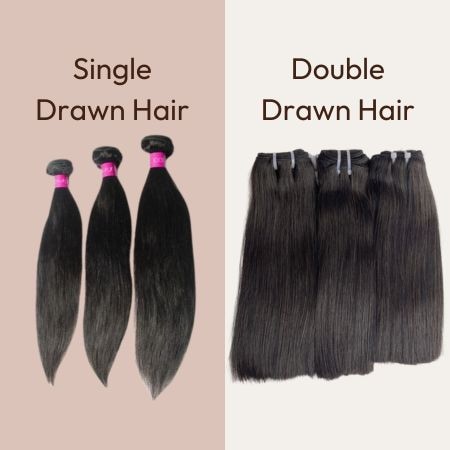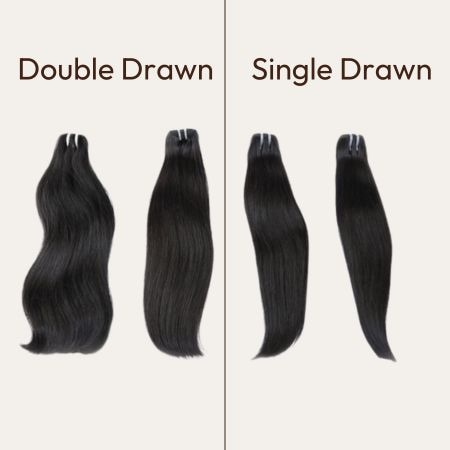When exploring the world of hair extensions, terms like single drawn and double drawn often pop up. But what do these terms mean, and how do they impact your hair goals? Whether you’re aiming for volume, length, or a flawless finish, understanding the differences between these two types of hair extensions is key to making the right choice. Let’s break it all down.

What Is Single Drawn Hair?
Each bundle of single-drawn hair is taken from one donor and then placed in a weft. The single-drawn weft emulates the real hair we have, giving the extensions a tapered appearance at the ends. A single-drawn extension is the most common extension type because of the less work involved in the processing and low cost.
Imagine a single drawn bundle as a ponytail with its ends looking naturally thinner than the roots.
Pros:
✅ Provides a realistic, natural finish.
✅ Works well for casual, everyday styles.
✅ More affordable, making it accessible for budget-conscious buyers.
Cons:
❌ Ends may appear thin or less full.
❌ Does not offer the "bouncy" volume that some prefer.
What Is Double Drawn Hair?
Double-drawn hair extensions have shorter hair removed by hand, workers cut the hair ends by hand so the full bundle will remain the same fullness from top to bottom, and then the hair will be sewn in a weft. This process would increase the quality of hair extensions and can provide you with a fuller appearance. Of course, you will pay more for double-drawn hair extensions, the quality and volume are better, and they will certainly last longer.
A double drawn bundle resembles a full, thick braid that's consistent in density from the roots to the tips.
Pros:
✅ Offers a thick, full-bodied look that’s uniform from root to tip.
✅ Requires fewer bundles for maximum impact.
✅ Long-lasting and durable.
Cons:
❌ Heavier, which may cause discomfort for those with fine or sensitive hair.
❌ Higher price due to intensive sourcing and processing.
Difference Between Single And Double Drawn Hair
While both single and double drawn extensions aim to enhance your hair’s beauty, their unique processing methods lead to distinct results in appearance, feel, and functionality. To summarize these contrasts at a glance:
| Feature | Single Drawn Hair | Double Drawn Hair |
| Length Consistency | Mixed lengths (natural variation) | Uniform lengths |
| Thickness | Light taper, thinner at the ends | Thick and full from root to tip |
| Price | More affordable | Higher cost |
| Ideal Look | Casual, natural layered styles | Ideal for sleek, polished looks |
| Longevity | Requires more upkeep | Low-maintenance over time |
Below, we dive into the core differences to help you visualize how they compare.
Length Consistency
★ Single Drawn: These extensions include strands of varying lengths (e.g., 18–22 inches), mirroring the natural unevenness of unprocessed hair. This creates subtle layers but lacks uniformity.
★ Double Drawn: Every strand is sorted to ensure identical lengths (e.g., all 20 inches). The meticulous removal of shorter hairs results in a seamless, “one-length” appearance.
Thickness and Density
★ Single Drawn: The mix of long and short hairs reduces overall density, offering moderate volume that blends naturally with fine or medium hair types.
★ Double Drawn: By eliminating shorter strands, these extensions achieve ultra-dense thickness, ideal for adding dramatic fullness or compensating for very thin hair.
Price Point
★ Single Drawn: Less labor-intensive processing keeps costs lower, making them a budget-friendly option for everyday wear.
★ Double Drawn: The extra sorting and higher hair quality required for uniformity justify the premium price tag.
Styling Flexibility
★ Single Drawn: Their layered texture works well for tousled waves, beachy styles, or haircuts with face-framing layers.
★ Double Drawn: The uniform length ensures sleek, polished styles (e.g., straight blowouts, high ponytails) hold their shape without flyaways.
Maintenance and Longevity
★ Single Drawn: May require occasional trimming to maintain a cohesive look as shorter hairs grow out.
★ Double Drawn: Retains its pristine appearance longer due to uniform strand lengths, reducing the need for frequent adjustments.
UNice Double Drawn Hair Weaves Recommendation
Looking for hair extensions that combine luxury, longevity, and a flawless finish? UNice double drawn hair weaves are designed to meet your highest expectations, delivering premium quality and unmatched versatility.
How to Choose Based on Your Hair Goals
When deciding between single drawn and double drawn hair extensions, your desired outcome and budget are key factors. Here’s a quick guide to help you choose:

Source: Pinterest
Choose Single Drawn Hair If:
✨ You want a natural, understated look.
✨ You're blending extensions with thin or fine natural hair.
✨ You're on a budget but still want high-quality extensions.
✨ You're trying extensions for the first time.
Choose Double Drawn Hair If:
✨ You need a thicker, more voluminous hairstyle.
✨ You’re planning to create glamorous, eye-catching styles.
✨ Longevity and durability are important to you.
✨ You’re willing to invest in premium options.
In summary, if you value affordability and a natural look, single drawn is a smart pick. For those craving maximum volume, uniformity, and versatility in styling, double drawn is worth the investment.
Conclusion
Neither single nor double drawn hair is inherently “better”—it all depends on your priorities. Always consider your hair type, lifestyle, and desired outcome before purchasing. And remember: whether single or double drawn, opt for premium hair grades for durability and a realistic look. Ready to transform your hair? Now you’re equipped to choose wisely!





